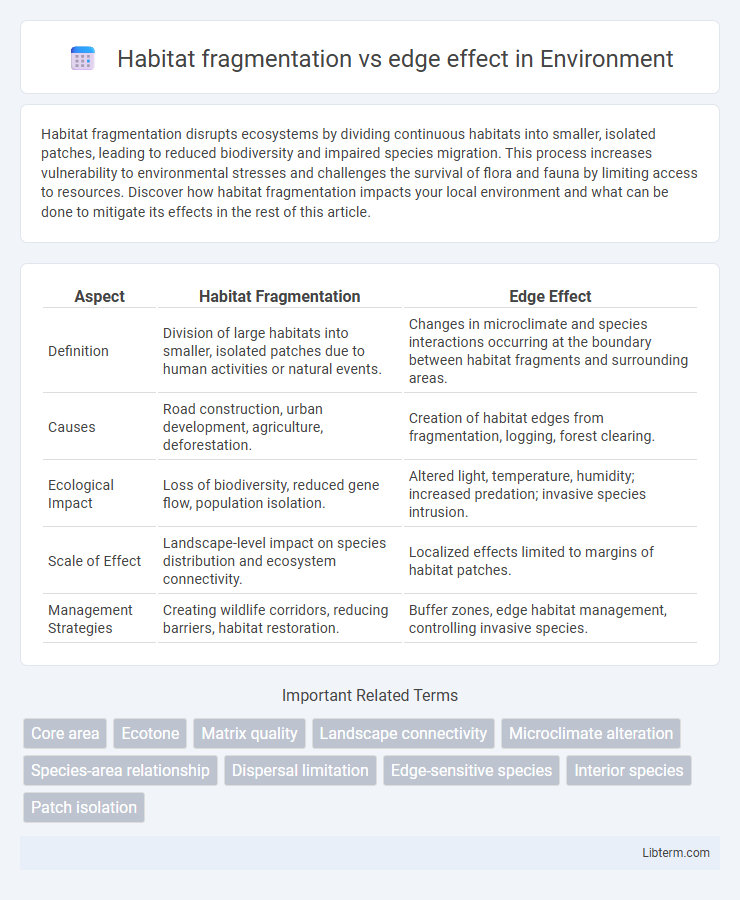Habitat fragmentation disrupts ecosystems by dividing continuous habitats into smaller, isolated patches, leading to reduced biodiversity and impaired species migration. This process increases vulnerability to environmental stresses and challenges the survival of flora and fauna by limiting access to resources. Discover how habitat fragmentation impacts your local environment and what can be done to mitigate its effects in the rest of this article.
Table of Comparison
| Aspect | Habitat Fragmentation | Edge Effect |
|---|---|---|
| Definition | Division of large habitats into smaller, isolated patches due to human activities or natural events. | Changes in microclimate and species interactions occurring at the boundary between habitat fragments and surrounding areas. |
| Causes | Road construction, urban development, agriculture, deforestation. | Creation of habitat edges from fragmentation, logging, forest clearing. |
| Ecological Impact | Loss of biodiversity, reduced gene flow, population isolation. | Altered light, temperature, humidity; increased predation; invasive species intrusion. |
| Scale of Effect | Landscape-level impact on species distribution and ecosystem connectivity. | Localized effects limited to margins of habitat patches. |
| Management Strategies | Creating wildlife corridors, reducing barriers, habitat restoration. | Buffer zones, edge habitat management, controlling invasive species. |
Introduction to Habitat Fragmentation and Edge Effect
Habitat fragmentation occurs when large, continuous habitats are divided into smaller, isolated patches, significantly altering ecosystems and species distributions. Edge effect refers to the changes in population or community structures that happen at the boundary of these fragmented habitats, often resulting in altered microclimates, increased predation, and invasive species invasion. Understanding both concepts is crucial for conservation efforts, as fragmentation increases edge habitats, intensifying ecological stress on native flora and fauna.
Defining Habitat Fragmentation
Habitat fragmentation refers to the process where large, continuous habitats are divided into smaller, isolated patches, often due to human activities like urban development and agriculture. This fragmentation reduces biodiversity by restricting movement and gene flow among wildlife populations. It directly influences the edge effect, where altered environmental conditions at habitat boundaries impact species composition and ecological processes.
Understanding Edge Effect: Concept and Mechanisms
Edge effect refers to the changes in population or community structures that occur at the boundary of two or more habitats, often resulting in increased biodiversity but also greater vulnerability for certain species. This phenomenon arises due to altered microclimates, increased light exposure, and higher predation rates at habitat edges, which differ significantly from interior habitat conditions. Understanding edge effect mechanisms is crucial for mitigating negative impacts of habitat fragmentation on ecosystem stability and species survival.
Causes of Habitat Fragmentation
Habitat fragmentation primarily results from human activities such as urban development, agriculture expansion, and road construction, which divide large continuous habitats into smaller, isolated patches. Natural causes like wildfires or storms can also contribute, but anthropogenic factors are the dominant drivers. This fragmentation increases edge effects by creating more habitat boundaries, altering environmental conditions and impacting species diversity.
Types of Edge Effects in Fragmented Habitats
Types of edge effects in fragmented habitats include abiotic changes such as altered microclimate conditions like temperature, humidity, and light intensity, which can significantly impact species composition. Biotic edge effects involve increased predation, invasion by edge-adapted species, and changes in pollinator interactions, often leading to reduced biodiversity. Furthermore, dispersal limitations and altered nutrient cycling at habitat edges modify ecosystem processes, causing cascading effects on fragmented landscapes.
Ecological Consequences of Habitat Fragmentation
Habitat fragmentation leads to the division of continuous habitats into smaller, isolated patches, significantly altering species distribution and ecosystem functions. The edge effect intensifies these changes by creating abrupt habitat boundaries that increase exposure to predators, invasive species, and microclimatic fluctuations. Ecological consequences include reduced genetic diversity, disrupted migration routes, and altered species interactions, which collectively threaten biodiversity and ecosystem resilience.
Biodiversity Impacts: Fragmentation vs Edge Effect
Habitat fragmentation isolates wildlife populations into smaller, disconnected patches, reducing genetic diversity and increasing extinction risk. Edge effects alter microclimates and species composition at habitat boundaries, often increasing invasive species and decreasing interior-specialist biodiversity. Both processes significantly disrupt ecosystems, but fragmentation primarily impacts population viability while edge effects mainly influence habitat quality and species interactions.
Species Vulnerability and Adaptation at Edges
Habitat fragmentation significantly increases species vulnerability by isolating populations and reducing genetic diversity, while edge effects create altered environmental conditions that challenge species' survival and adaptation. Species at habitat edges often face increased exposure to predators, microclimatic changes, and invasive species, forcing rapid behavioral and physiological adaptations. Those unable to adjust to these edge environments experience higher mortality rates and population declines, emphasizing the critical role of habitat continuity for biodiversity conservation.
Conservation Strategies Addressing Both Challenges
Conservation strategies addressing habitat fragmentation and edge effects prioritize creating wildlife corridors and buffer zones to maintain ecosystem connectivity and reduce habitat isolation. Implementing restoration projects that expand core habitat areas minimizes edge-related stressors such as microclimate changes and invasive species intrusion. Adaptive management approaches integrating land-use planning, protected area design, and community engagement enhance resilience against fragmentation impacts and preserve biodiversity.
Future Research Directions on Fragmentation and Edge Effects
Future research on habitat fragmentation and edge effects should prioritize the integration of landscape-scale ecological modeling with remote sensing technologies to capture dynamic spatial patterns and habitat connectivity changes. Advancements in genetic studies and species-specific behavioral analyses will enhance understanding of edge microclimate impacts and species adaptability. Emphasizing multispecies interactions and ecosystem services in fragmented landscapes will provide comprehensive insights into biodiversity conservation strategies under climate change scenarios.
Habitat fragmentation Infographic

 libterm.com
libterm.com